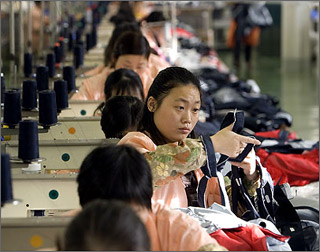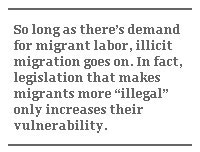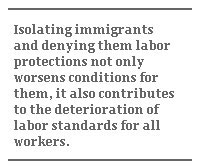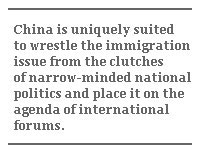Chinese Migration Goes Global
Chinese Migration Goes Global

abandoned by Romanians who seek opportunity in Western Europe
NEW YORK: Since the end of the Cold War, some 181 million people have left their homes to find opportunities elsewhere in the world, not only from the poor nations to the rich, but from the poor to the less poor nations. This movement is fluid, its impact not confined to individual nations.
And perhaps no group has had more visible impact than the 18 million Chinese who have left China since the economic reforms of the late 1970s – just over half of the approximately 35 million Chinese who live outside of China in what has become known as the Chinese diaspora.

Chinese emigrants these days, be it skilled professionals, businessmen or laborers, prefer North America and Western Europe as their destination, but also settle for Argentina, South Africa, Mauritius, Israel, Dubai or the like, countries not previously associated with the notion of Chinese migration – 150 countries in all. In Romania, Chinese immigrants eliminated labor shortages created after some 2 million Romanians emigrated to Spain and Italy after the fall of communism. Chinese women employed in Romanian textile factories are paid US $260 per month – four times more than what they would earn in China, but a sum for which Romanians are no longer willing to work.
The driving force behind Chinese emigration is the monumental demographic shift of its 1.4 billion population induced by China’s rapid economic expansion. Some 200 million people have left homes in rural China for jobs in the cities. The unprecedented influx has created overcrowding, social disorder and downward pressure on wages in the cities, as the Chinese economy, even with impressive double-digit growth, fails to create enough jobs to accommodate all rural migrants. Thus the most ambitious among them see leaving China as an attractive option.
The post-Cold War global migration, however, takes place within the old framework of nation states. While the capital and goods flow freely across national borders to the drumbeat of open markets and free trade, the movement of people is all but free. Ordinary citizens of developed receiving nations are unwilling to accept mass immigration in fear of losing their jobs, clinging onto the concept of national borders as a guarantee against such fears.

But their concerns are not shared by employers, who want to hire immigrants to cut costs and who hope that the force of global migration will weaken national labor movements and labor standards. Thus, although jobs wait for the mobile plucky takers in many nations, unless they are skilled professionals, the immigrants must enter borders illegally or on temporary visas. Chinese emigrants are so motivated that they willingly pay organized crime networks tens of thousands of dollars to be smuggled to their destinations by perilous means, often with tragic consequences. In 2000 British authorities found 58 illegal Chinese immigrants asphyxiated aboard a tomato truck in the port city of Dover.
Governments make repeated attempts to strengthen border controls and beef up criminal sanctions against illegal immigrants and their smugglers, but so long as there is demand for migrant labor, the illicit migration goes on. In fact, legislation that makes migrants more “illegal” only increases their vulnerability, therefore cheaper for the employers to engage. The profits from smuggling also increase. It now costs $30,000 for a Chinese to be smuggled into the UK and $70,000 to the US – roughly double of what it was a little more than a decade ago.
After illegal immigrants enter a country, they have no access to regular labor markets or the benefit of labor-protection laws. Forced underground, Chinese immigrants squeeze into niche trades, usually employed by co-ethnic subcontractors. Because such immigrants work for and alongside fellow Chinese by necessity, not by choice, they become targets for resentment and accusations of sticking to their own. In late 2006 local residents in Tonga – furious that the Chinese businesses recruited Chinese from China instead of employing from the local population – looted and burned more than 30 Chinese-run shops.

Of course, Chinese workers don’t necessarily have common interests with their Chinese bosses. While some 2,000 Chinese entrepreneurs own a quarter of the textile businesses in Prato, Italy, an army of low-wage workers recruited in China works long nights, sweatshop-style, to produce low-cost “Made in Italy” fashions for export to Eastern Europe. In New York City, Chinese restaurant and garment workers frequently wage battles against their co-ethnic employers for abuses such as withholding of back wages and confiscation of service tips. Because American unions refuse to consider them a part of America’s legitimate working class, the workers must fight it alone, without help from the labor authorities. Isolating immigrants and denying them labor protections not only worsens conditions for them, it also contributes to the deterioration of labor standards for all workers. And in the end, none of the measures heretofore taken have deterred immigration.
The disconnect between national policy and the logic of global migration underlines the necessity for governments to work together in finding new ways to protect their citizens’ living standards while guaranteeing immigrants the right to work without undue exploitation. Unfortunately, most politicians are interested in exploiting anti-immigrant sentiments to generate populist support and win elections.
Russia’s Far East region has about 100,000 permanent Chinese residents. Most are merchants, selling clothes, toys and other consumer goods. Since their inflow coincided with the dwindling of Russian population in the region, a belief has taken hold among many Russians that China has adopted a state program of “Moving to the North.” They see the Chinese as a sign of a creeping annexation of Russian territory. Adding to the fears is the fact that China controlled most of that region until the 1850s. President Vladimir Putin plays on this fear when he warns that, if the government does not introduce immigration restrictions, people in Russia’s Far East could soon all speak Chinese – even as his experts agree that Russia needs Chinese labor and resources to develop this region.
Since the fall of communism in Eastern Europe, many conservatives in the US consider China a principal threat to the US and call for military containment, reminiscent of the Cold War era. Periodically, they accuse Chinese Americans of acting as the “fifth column” for China, as when they called for the investigation of Chinese-American contributors to President Bill Clinton’s re-election campaign, suspected of helping the Chinese Communist government channel money to influence US politics.

Despite signs of growing anti-Chinese sentiment in many quarters of the world, the Chinese government remains largely silent. For one, it has no incentive to tamper with the exodus of its citizens, which eases domestic unemployment and reaps the benefits of remittances – to the tune of US $20 billion a year. Secondly, any active involvement could arouse suspicion regarding the loyalty of the overseas Chinese.
But China should not remain a detached spectator of global migration, especially as it grapples with its own problem of illegal immigration from North Korea. As a nation both on the receiving and sending side, perhaps China is uniquely suited to wrestle the issue from the clutches of narrow-minded national politics and place it on the agenda of international forums. With graying populations in northern Europe, Japan and even China and the need for young workers to maintain growth required for social stability, the issue of global migration has assumed urgency for the whole world and deserves timely attention and appropriate multinational treatment.
Peter Kwong is a professor in the Asian American Studies Program of Hunter College and professor of sociology with the City University of New York.
Comments
Information good
I'm concerned that the Chinese government is also assuming money power over overseas leaders